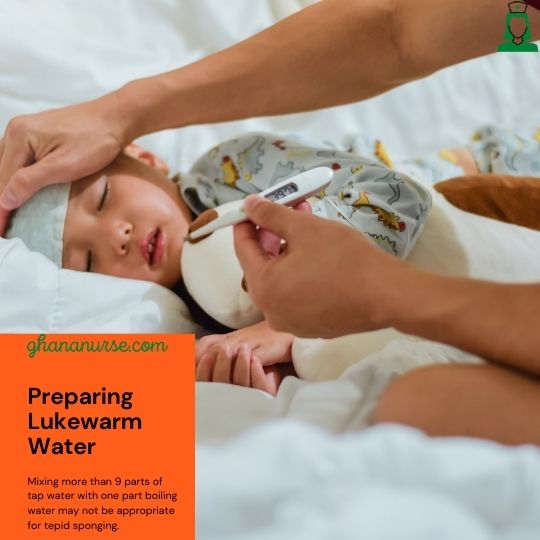How Hot Should Water For Tepid Sponging Be; And How Do You Determine That Without A Thermometer
Preparing Lukewarm Water; a safe and reliable way
The word “lukewarm” popped up around the 14th century as meaning “slightly warm”. Lukewarm water is water that is slightly warm, moderately warm or neither hot nor cold. It has many uses in homes and industries. In homes, especially in the kitchen, it helps in the preparation of lots of delicacies such as Palm Nut Soup (a Ghanaian soup made from nut) whereas it becomes a strong ally of many children and adults during winter, rainy season or harmattan.
In healthcare, lukewarm water is used for managing fever. Patients with high body temperature are sponged with lukewarm water to reduce their body temperature. Sponging with cold water can increase core body temperature by cooling the skin and causing shivering.
Even though preparing lukewarm water may not require special skill or training, often clinicians or users stumble on the temperature of the water. ‘How cold or hot should a lukewarm be’ is one of the many questions often debated.
Different sources have provided differing temperature range for lukewarm water. Some references say it is between 100 and 110 F (36.5 to 40.5 C). But others report lukewarm water falls between 98 and 105 F. There are schools of thought that lukewarm means room temperature (72 to 74 F), and others believe it means body temperature (98.6 F), while one definition is adding 15 degrees to room temperature water. However, the basic underpinning is that the temperature of lukewarm water must be like that of the user or patient; must not be too less or more than the temperature of the user.
In preparing lukewarm water, the correct way to determine the temperature of the water is to use a thermometer. However, this is not handy in many homes and hospitals, making it challenging to prepare one at the right temperature. The traditional way of testing the temperature of lukewarm water is to run the water over the wrist or back of palm. You note as the right temperature, when the water is not warmer or colder than your body temperature.
However, the challenge with this is scalding. There is a high chance of running hot water on your wrist with this method. Research has found that water even at 48C remains dangerous for the human skin.
Study
A study was done to measure the temperatures of mixtures (hot and cold water) under four different conditions. In all the instances, boiling water was mixed with tap water. One (1) part of hot water was mixed with 1,2, 3, 4, 5, 6, 7, 8, 9, 10, 11, 12, 13 and 14 part of cold water. However, complete data was not gotten for mixing one part of hot water with 1, 2, 3, 4, 11, 12, 13, and 14 part of cold water under all the four different conditions. Either it was unrecordable (outside the range of the thermometer) or was recorded but below 34.0. The study was done within 14days (15th to 28th February 2021).
Different Conditions Test Was Done
| Condition | 1st Study | 2nd Study | 3rd Study | 4th Study |
| Type of Tap Water | Tap water fetched in a barrel overnight | Tap water fetched in a barrel overnight | Straight from the tap | Straight from the tap |
| Type of Hot Water | Boiling water from electric kettle | Boiling water from stove | Boiling water from stove | Boiling water from stove |
| Time of Day | Afternoon | Morning | Morning | Night |
| Quantity of water per part | 10mls | 400mls | 400mls | 400mls |
Results
| Aggregate of Boiling Water to Tap Water | 1st Study | 2nd Study | 3rd Study | 4th Study | Average |
| 1 to 5 | 39.6 | 41.7 | 38.2 | 40.0 | 39.9 |
| 1 to 6 | 38.4 | 41.3 | 37.3 | 38.9 | 39.0 |
| 1 to 7 | 38.2 | 39.6 | 36.1 | 37.9 | 38.0 |
| 1 to 8 | 37.7 | 38.7 | 35.5 | 36.4 | 37.1 |
| 1 to 9 | 37.0 | 37.9 | 34.4 | 35.9 | 36.3 |
| 1 to 10 | 35.9 | 37.2 | 34.2 | 35.6 | 35.7 |
| All temperature readings are in Degrees Celsius | |||||
Recommendations
Using a lukewarm water range of 36.5C to 40.5C, it is recommended that
- In using the traditional means of preparing lukewarm water, it will be safer to run water on the wrist to test the temperature of the water only when at least 5 parts of tap water has been mixed with one boiling water. This is to prevent possible scalding.
- Mixing more than 9 parts of tap water with one part boiling water may not be appropriate for tepid sponging.
Recommended Procedure for Preparing Lukewarm Water For Tepid Sponging
- Heat water till it boils
- Use a cup or any other container to fetch a portion of the boiling water into a bucket or a bigger container.
- Using same cup or container used to fetch the hot water, fetch five portions of tap water into the same bucket.
- Stir and run a little of the mixture on your wrist or at the back of your palm.
- If it is hotter than your desired water temperature, use same cup to fetch another portion of tap water and add
- Repeat procedure step ‘4’ and ‘5’ till you get to your desired water temperature
- When using for tepid sponging, do not exceed mixing 9 part of tap water with 1 part of boiling water.
REFERENCE
- Shields, W. C., McDonald, E., Frattaroli, S., Perry, E. C., Zhu, J., & Gielen, A. C. (2013). Still too hot: examination of water temperature and water heater characteristics 24 years after manufacturers adopt voluntary temperature setting. Journal of burn care & research : official publication of the American Burn Association, 34(2), 281–287. https://doi.org/10.1097/BCR.0b013e31827e645f
- <https://www.wonderopolis.org/wonder/how-hot-is-lukewarm>
- https://www.thespruceeats.com/how-hot-is-lukewarm-water-1706102>
- <https://www.todayifoundout.com/index.php/2012/08/origin-of-the-word-lukewarm/>
- https://www.abc.net.au/health/features/stories/2015/03/12/4123222.htm>




